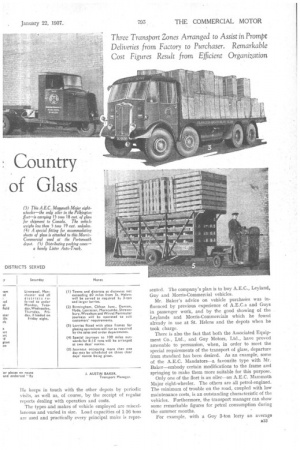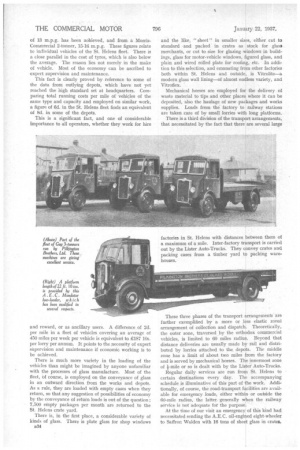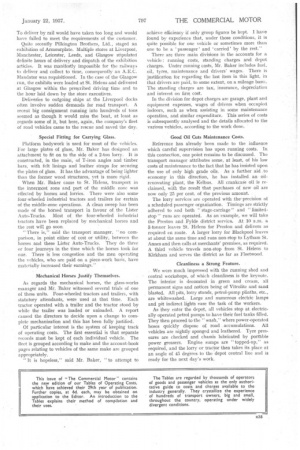Covering t with Loa( Country of Glass
Page 42

Page 43

Page 44

Page 45

If you've noticed an error in this article please click here to report it so we can fix it.
TAKING into account 30 vehicles operated by several subsidiary companies, Pilkington Brothers, Ltd., the noted glass-making concern of St. Helens and Doncaster, which owns a fleet of 155 motor vehicles, is one of the largest ancillary users in this country. Mr. J. Austin Baker, M.I.Mech.E., M.I.A.E., F.C.W.A., the company's transport manager, has had a wide experience of all forms of transport on land.
He graduated in the commercial motor engineer's department of a railway company and then passed to municipal transport, where he had control of trams, trolleybuses and motorbuses. At St. Helens he is in charge of 155 motor vehicles of all sizes and descriptions, including a number of mechanical horses and Lister Auto-Trucks.
His views on practically any aspect of road transport are, therefore, bound to be valuable. He is unprejudiced, because Pilkington Brothers, Ltd., makes use of all forms of transport, leaning neither to one nor to another, but choosing for any particular job that which offers best service, having regard to all the conditions of cost, time and general suitability.
The fleet is scattered, being distributed among 11 city and town depots in an area stretching from Glasgow to Southampton. The general policy is one Df decentralization, each depot being, to a large extent, self-contained, with its own garage, staff and maintenance department. Mr. Baker himself has his offices and sta# at St. Helens, where are located 35 orthodox commerci I vehicles, with three mechanical horses and five Lister Auto-Tractors.
He keeps in touch with the other depots by periodic visits, as well as, of course, by the receipt of regular reports dealing with operation and costs.
The types and makes of vehicle employed are miscellaneous and varied in size. Load capacities of 1-16 tons are used and practically every principal make is repre
sented. The company's plan is to buy A.E.C., Leyland, Guy and Morris-Commercial vehicles.
Mr. Baker's advice on vehicle purchases was influenced by previous experience of A.E.C.s and Guys in passenger work, and by the good showing of the Leylands and Morris-Commercials which he found already in use at St. Helens and the depots when he took charge.
There is also the fact that both the Associated Equipment Co., Ltd., and Guy Motors, Ltd., have proved amenable to persuasion, when, in order to meet the special requirements of the transport of glass, departure from standard has been desired. As an example, some of the A.E.C. Mandators—a favourite type with Mr. Baker—embody certain modifications to the frame and springing to make them more suitable for this purpose.
Only one of the fleet is an oiler—an A.E.C. Mammoth Major eight-wheeler, The others are all petrol-engined. The minimum of trouble on the road, coupled with low maintenance costs, is an outstanding characteristic of the vehicles. Furthermore, the transport manager can show some remarkable figures for petrol consumption during the summer months.
For example, with a Guy 3-ton lorry an average o.13 m.p.g. has been aohieved, and from a MorrisCommercial 2-tonner, 15-10 m.p.g. These figures relate to individual vehicles of the St. Helens fleet. There is a close parallel in the cost of tyres, which is also below the average. The reason lies not merely in the make of vehicle. Most of the economy can be ascribed to expert supervision and maintenance.
This fact is clearly proved by reference to some of the data from outlying depots, which have not yet. reached the high standard set at headquarters. Comparing total running costs per mile of vehicles of the same type and capacity and employed on similar work, a figure of 6d. in the St. Helens fleet finds an equivalent of 8d. in some of the depots.
This is a significant fact, and one of considerable importance to all operators, whether they work for hire and reward, or as ancillary users. A difference of 2d. per mile in a fleet of vehicles covering an average of 450 miles per week per vehicle is equivalent to £187 10s. per lorry per annum. It points to the .necessity of expert supervision and maintenance if economic working is to be achieved.
There is much more variety in the loading of the vehicles than might be imagined by anyone unfamiliar with the processes of glass manufacture. Most of the fleet, of course, is employed on the conveyance of glass in an outward direction from the works and depots. As a rule, they are loaded with empty cases when they return, so that any suggestion of possibilities of economy by the conveyance of return loads is out of the question ; 7,500 empty packages per month are returned to the St. Helens crate yard.
There is, in the first place, a considerable variety of kinds of glass. There is plate glass for shop windows B34
and the like, "sheet " in smaller si*s, either cut to standard •and packed" in crates as stock for glass merchants, or cut to size for glazing windows in buildings, glass for motor-vehicle windows, figured glass, and plain and wired rolled plate for roofing, etc. In addition to this selection, and emanating frchn other factories both within St. Helens and outside, is Vitrolite—a modern glass wall lining—of almost endless variety, and Vitroflex. .
Mechanical horses are employed for the delivery of waste material to tips and other places where it can be deposited, also the haulage of new packages and works supplies. Loads from the factory to railway stations are taken care of by small lorries with long platforms. There is a third division of the transpt rt arrangements, that necessitated by the fact that there are several large factories in St. Helens with distances between them of a maximum of a mile. Inter-factory transport is carried out by the Lister Auto-Trucks. They convey crates and packing cases from a timber yard to packing warehouses.
These three phases of . the transport arx-angenients are further exemplified by a more or less elastic zonal arrangement of collection and dispatch. Theoretically, the outer zone, traversed. by the orthodox commercial vehicles, is limited to 60 miles radix* Beyond that distance deliveries are usually made bir rail and distributed by lorries attached to the depots. The middle zone has a limit of about two miles from the factory and is served by mechanical horses. The innermost zone. of i-mile or so is dealt with by the Lister Auto-Trucks. Regular daily services are run from St. Helens to certain destinations every day. The accompanying schedule is illuminative of this part of the work. Addl.:. tionally, of course, the road-transport facilities are avail. able for emergency loads, either within or outside the 60-mile radius, the latter generally when the railway service is not Adequate for the purpose
At the time of our visit an emergency of this kind had necessitated sending the A.E.C. oil-engi ed eight-wheeler to Saffron Walden with 16 tons of sheet glass in crates. To deliver by rail would have taken too long and would have failed to meet the requirements of the customer.
Quite tecently Pilkington Brothers, Ltd., staged an exhibition of Armourplate. Multiple stores at Liverpool, Manchester, Leicester, Leeds, and Glasgow stipulated definite hours of delivery and dispatch of the exhibition articles. It was manifestly impossible for the railways to deliver and collect to time, consequently an A.E.C. Mandator was requisitioned. In the case of the Glasgow run, the exhibits were loaded at St. Helens and delivered at Glasgow within the prescribed driving time and to the hour laid down by the store executives.
Deliveries to outgoing ships at the Liverpool docks often involve sudden demands for road transport. A recent big consignment running into hundreds of tons seemed as though it would miss the boat, at least as regards some of it, but here, again, the company's fleet of road vehicles came to the rescue and saved the day.
Special Fitting for Carrying Glass.
Platform bodywork is used for most of the vehicles. For large plates of glass, Mr. Baker has designed an attachment to fit on to the side of a 2-ton lorry. It is constructed, in the main, of T-iron angles and timber bars, with felt linings and leather straps for securing the plates of glass. It has the advantage of being lighter than the former wood structures, yet is more rigid.
When Mr. Baker came to St. Helens, transport in the innermost zone and part of the middle zone was effected by horses and lorries. There were also somefour-wheeled industrial tractors and trailers for certain of the middle-zone operations. A clean sweep has been made of the h6rsed transport in favour of the Lister Auto-Trucks. Most of the four-wheeled industrial tractors have been replaced by mechanical horses and the rest will go soon.
"There is," said the transport manager, "no comparison, in point either of cost or utility, between the horses and these Lister Auto-Trucks. They do three or four journeys in the time which the horses took for one. There is less congestion and the men operating the vehicles, who are paid on a piece-work basis, have materially increased their earnings."
Mechanical Horses Justify Themselves.
As regards the mechanical horses, the glass-works manager and Mr. Baker witnessed several trials of one of these units, Four-wheeled tractors and trailers, with statutory attendants, were used at that time. Each tractor operated with a trailer and the tractor stood by while the trailer was loaded or unloaded. A report caused the directors to decide upon a change to complete mechanization and this has been fully justified.
Of particular interest is the system of keeping track of operating costs. The first essential is that separate records must be kept of each individual vehicle. The fleet is grouped according to make and the account-book pages relating to vehicles of the same make are grouped appropriately.
"It is hopeless," said Mr. Baker, "to attempt to achieve efficiency if only group figures be kept. I have found by experience that, under those conditions, it is quite possible for one vehicle or sometimes more than one to be a 'passenger' and ' carried ' by the rest."
There are three main divisions in the accounts for a vehicle : running costs, standing charges and depot charges. Under running costs, Mr. Baker includes fuel, oil, tyres, maintenance and drivers' wages. There is justification for regarding the last item in this light, in that drivers are paid, to some extent, on a mileage basis. The standing charges are tax, insurance, depreciation and interest on first cost.
In the division for depot charges are garage, plant and equipment expenses, wages of drivers when occupied indoors, such as when assisting in some maintenance operation, and similar expenditure. This series of costs is subsequently analysed and the details allocated to the various vehicles, according to the work done.
Good Oil Cuts Maintenance Costs.
Reference has already been made to the influence which careful supervision has upon running costs. In this connection, one point remains to be discussed. The transport manager attributes some, at least, of his low costs of maintenance to the fact that he has insisted upon the use of only high grade oils. As a further aid , to economy in this direction, he has installed, an oil'. renovating plant, the Kelbus. All crankcase oil is reclaimed, with the result that purchases of new oil are now only 25 per cent of the previous amount.
The lorry services are operated with the, precision of a scheduled passenger organization. Timings are strictly adhered to and both " stage-carriage " and " limitedstop " runs arc operated. As an 'example, we will take the Preston and Fylde district service,. At 10 a.m. a 3-tonner leaves St. Helens for Preston and delivers as required en route. A larger lorry for Blackpool leaves at about the same time and runs non-stop to Lytham St. Annes and then calls at merchants' premises, as required. A third vehicle travels non-stop from St. Helens to Kirkham and serves the district as far as Fleetwood.
Cleanliness a Strong Feature.
We were much impressed with the running shed and central workshops, of which cleanliness is the keynote. The interior is decorated in green and cream, all permanent signs and notices being of Vitrolite and sand blasted. All pits, lorry stands, petrol-pump plinths, etc., are whitewashed. Large and numerous electric lamps and pit indirect lights ease the task of the workers.
As they enter the depot, all vehicles stop at. electrically operated petrol pumps to have their fuel tanks filled. They then proceed to the " wash," where power-operated hoses quickly dispose of road accumulations. All vehicles are nightly sponged and leathered. Tyre pressures are checked and chassis lubricated by portable power greasers. Engine sumps are "topped-up," as required, and the lorry or tractor then takes its place at an angle of 45 degrees to the 'depot central line and is ready for the next day's work.
















































































































